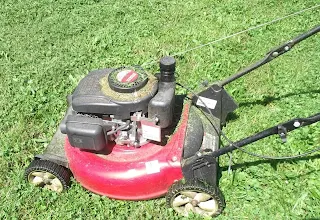It has been difficult to keep the lawn mowed.
Engineers
Two areas were investigated to establish "Standard Rates".
The Orchard
The orchard can be safely characterized as "rough" mowing. Progress was slowed by the need to stop and unclog the mower and to pick up trash.
It took 58 minutes to mow a rectangle that is 120 feet long by 75 feet wide for an average of 6.7 minutes for every 1000 ft^2 (a little less than 100 m^2). That works out to an average speed of 1.6 fps, 1.1mph or 0.5 m/s.
The yard
The yard had not been mowed for 10 days and we have had 2" of rain in that time. While not "hard" mowing, I could not move at a full walking pace due to issues with clogging.
I now use a back-and-forth pattern to minimize nutrient migration to the perimeter of the yard. That means that half of my passes are sucking up the clippings from the previous pass.
It is possible that the plastic deflector, ahem, fell off.
Obstacles are handled by using a shadow algorithm. The goal is to maximize length of mowing and minimize the number of turns. Turns take time and no grass is actually cut during that time.
Nearly all turns will be 180 degree turns. The "shaded areas" are mowed after the light green area.
 |
| Left-to-right, clothesline posts, bonfire pit, chair, persimmon tree, utility pole, arborvitae tree, picnic table. |
Standard rate calculations
A "safe" starting point for calculating actual time spent pushing a standard hand mower is to calculate the square footage of the yard. For small yards or yards with many obstacles (the default), figure on 3.5 minutes for every 1000 square feet. For large yards with fewer obstacles figure on 3.0 minutes per 1000 square feet.
Just for perspective, a regulation high school football field measures 120 yards (with end zones) by 53.3 yards wide. That would take 2.9 hours of actual mow time if mowed with a hand mower. It makes me ponder what would happen if six Eaton Rapids linemen mowed the field twice a week all summer long for conditioning. That would be a half hour of pushing the mower, twice a week for each of them. And....they would know that field like the back of their hands.
For yards that are large, very flat and smooth with no obstacles and have little clipping weight it may be possible to drop down to 2.7 minutes for every 1000 square feet. That is an average speed of 2.8 miles per hour.
These times assume a single pass.
See, math can be fun!




Either fun OR depressing... Depends on how much yard and how long since the last mowing... :-) I could have used that as a 12 year old to calculate a better price model than $2 for an entire yard... sigh
ReplyDeleteOld Mizzuz Potter would not even pay me $2. She put a stop watch on me and declared that she could NOT pay me that much because I would be making as much money, per hour, as a grown man working in a factory.
DeleteEfforts to explain that I was supplying my own equipment, gasoline and had "walk time" fell on deaf ears.
I kept mowing her grass because nobody else would.
Either fun OR depressing... Depends on how much yard and how long since the last mowing... :-) I could have used that as a 12 year old to calculate a better price model than $2 for an entire yard... sigh
ReplyDelete